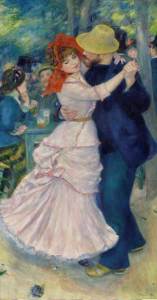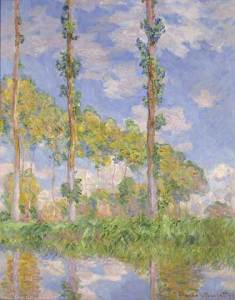The National Gallery’s latest exhibition celebrates the life of Paul Durand-Ruel, the maverick French art dealer who first championed the Impressionists. By mid September, the same show will have toured three cities, in three separate countries, and will have picked up three different titles along the way.
At the Musée du Luxembourg in Paris (9 October 2014–8 February 2015), the show opened as ‘Le pari de l’impressionnisme’ (Gambling on Impressionism). Here in London it is known as ‘Inventing Impressionism’ (4 March–31 May), and at the Philadelphia Museum of Art (24 June–13 September) it will become, ‘Discovering the Impressionists: Paul Durand-Ruel and the New Painting’.

Dance at Bougival (1883), Pierre-Auguste Renoir © 2014 Museum of Fine Arts, Boston
The emphasis on risk in the Musée du Luxembourg’s title paints the dealer in a rather devil-may-care light. The organisers are keen to stress that Durand-Ruel’s investment was ‘a very real gamble’ and that his backing of the Impressionists was unique in its foresight, daring and expense.
Aged 88 Durand-Ruel famously stated that, ‘my madness had been wisdom. To think that, had I passed away at sixty, I would have died debt-ridden and bankrupt, surrounded by a wealth of underrated treasures’. His financial troubles are well documented, but he was also known to dabble in the more reliable market for Old Masters and had previously enjoyed great success promoting the works of the Barbizon school.
The title adopted in Philadelphia is the most cautious. The emphasis here on discovery and ‘New Painting’ gives much more credit to the artists themselves. Almost as if Durand-Ruel simply stumbled across buried treasure, the title portrays him more as a facilitator or agent than a source of individual creativity.
American exhibitions of European art often focus, rather tediously, on the nation’s history of collecting. This exhibition is no exception, but here the emphasis is wholly justified. Arguably, the triumph of Impressionism was fuelled by American demand. From the 1880s onwards, Durand-Ruel patiently nurtured this new market, establishing a public thirst that has yet to be quenched.
The National Gallery’s title is perhaps the most daring of the three. Rather than a chancer or canny prospector, here Durand-Ruel is posited as none other than the inventor of Impressionism – a bold statement, but one that can be easily justified.

Poplars in the Sun (1891), Claude Monet © National Museum of Western Art, Tokyo
In 1871, when Durand-Ruel first met Monet in London, the Impressionist group had yet to be founded, let alone named. By the time of his death in 1922, an estimated 12,000 pictures by the likes of Renoir, Pissarro, Monet and Degas had passed through the dealer’s hands.
When asked about Durand-Ruel’s formative role in promoting Impressionism, a National Gallery spokesperson said that the curators wanted to highlight, ‘the strategies the dealer devised to make their [the Impressionists] creative journey a success story’. A founding father of the International art market, those strategies included innovative solo exhibitions and even monthly stipends that, in a very real sense, ensured the creation of so many cherished artworks.
Gambler, discoverer or inventor – to an extent Paul Durand-Ruel was all three. The enduring popularity of Impressionism is a testament to his labours. ‘This is my big crime, bigger than all the others’, he said in 1885, ‘I have long been buying, and to a very great extent, the works of very original and talented painters, several of whom are real geniuses’.
‘Inventing Impressionism’ is at the National Gallery, London until 31 May.
Related articles
The New Deal: Paul Durand-Ruel (Caroline Rossiter; from the September 2014 issue of Apollo)
Editor’s Letter: A Historic Business (Thomas Marks)
The story behind ‘Telling Tales’ at the Frist Center for Visual Arts (Mark Scala)

Paul Durand-Ruel: Gambler, Discoverer or Inventor?
Photograph of Paul Durand-Ruel in his gallery (c. 1910), taken by Dornac Archives Durand-Ruel © Durand-Ruel & Cie
Share
The National Gallery’s latest exhibition celebrates the life of Paul Durand-Ruel, the maverick French art dealer who first championed the Impressionists. By mid September, the same show will have toured three cities, in three separate countries, and will have picked up three different titles along the way.
At the Musée du Luxembourg in Paris (9 October 2014–8 February 2015), the show opened as ‘Le pari de l’impressionnisme’ (Gambling on Impressionism). Here in London it is known as ‘Inventing Impressionism’ (4 March–31 May), and at the Philadelphia Museum of Art (24 June–13 September) it will become, ‘Discovering the Impressionists: Paul Durand-Ruel and the New Painting’.
Dance at Bougival (1883), Pierre-Auguste Renoir © 2014 Museum of Fine Arts, Boston
The emphasis on risk in the Musée du Luxembourg’s title paints the dealer in a rather devil-may-care light. The organisers are keen to stress that Durand-Ruel’s investment was ‘a very real gamble’ and that his backing of the Impressionists was unique in its foresight, daring and expense.
Aged 88 Durand-Ruel famously stated that, ‘my madness had been wisdom. To think that, had I passed away at sixty, I would have died debt-ridden and bankrupt, surrounded by a wealth of underrated treasures’. His financial troubles are well documented, but he was also known to dabble in the more reliable market for Old Masters and had previously enjoyed great success promoting the works of the Barbizon school.
The title adopted in Philadelphia is the most cautious. The emphasis here on discovery and ‘New Painting’ gives much more credit to the artists themselves. Almost as if Durand-Ruel simply stumbled across buried treasure, the title portrays him more as a facilitator or agent than a source of individual creativity.
American exhibitions of European art often focus, rather tediously, on the nation’s history of collecting. This exhibition is no exception, but here the emphasis is wholly justified. Arguably, the triumph of Impressionism was fuelled by American demand. From the 1880s onwards, Durand-Ruel patiently nurtured this new market, establishing a public thirst that has yet to be quenched.
The National Gallery’s title is perhaps the most daring of the three. Rather than a chancer or canny prospector, here Durand-Ruel is posited as none other than the inventor of Impressionism – a bold statement, but one that can be easily justified.
Poplars in the Sun (1891), Claude Monet © National Museum of Western Art, Tokyo
In 1871, when Durand-Ruel first met Monet in London, the Impressionist group had yet to be founded, let alone named. By the time of his death in 1922, an estimated 12,000 pictures by the likes of Renoir, Pissarro, Monet and Degas had passed through the dealer’s hands.
When asked about Durand-Ruel’s formative role in promoting Impressionism, a National Gallery spokesperson said that the curators wanted to highlight, ‘the strategies the dealer devised to make their [the Impressionists] creative journey a success story’. A founding father of the International art market, those strategies included innovative solo exhibitions and even monthly stipends that, in a very real sense, ensured the creation of so many cherished artworks.
Gambler, discoverer or inventor – to an extent Paul Durand-Ruel was all three. The enduring popularity of Impressionism is a testament to his labours. ‘This is my big crime, bigger than all the others’, he said in 1885, ‘I have long been buying, and to a very great extent, the works of very original and talented painters, several of whom are real geniuses’.
‘Inventing Impressionism’ is at the National Gallery, London until 31 May.
Related articles
The New Deal: Paul Durand-Ruel (Caroline Rossiter; from the September 2014 issue of Apollo)
Editor’s Letter: A Historic Business (Thomas Marks)
The story behind ‘Telling Tales’ at the Frist Center for Visual Arts (Mark Scala)
Unlimited access from just $16 every 3 months
Subscribe to get unlimited and exclusive access to the top art stories, interviews and exhibition reviews.
Share
Recommended for you
Editor’s Letter: The single-artist museum
The single-artist museum
The Week’s Muse: 28 February
View Festival of Art History; the Christie’s purchase of Collectrium; Mark Scala on Telling Tales
Women artists get a raw deal in historical collections. Will that ever change?
The imbalance seems historically ingrained. But surely museums could do more to explain it